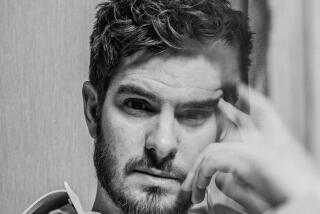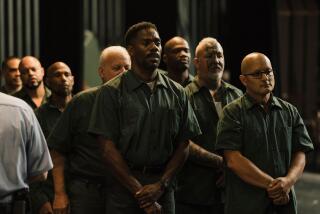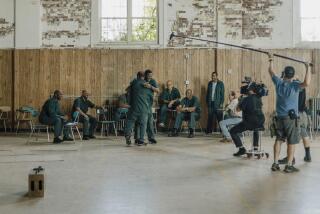Spalding Gray, 62; Master of the Monologue
Spalding Gray, the masterful monologuist of “Swimming to Cambodia” fame, who turned his darkest fears about life and death into riveting one-man theater pieces that defined the genre, was confirmed dead Monday when a body found in the East River in New York City was identified as his. He was 62.
Gray, who lived on Long Island but kept an apartment in New York City, was reported missing by his wife, Kathleen Russo, on Jan. 11 after he missed a meeting with a friend and a scheduled flight to Aspen for a ski trip.
While clinging to hope, his family and friends feared the worst after a witness reported seeing a despondent-looking man who matched Gray’s description on the Staten Island ferry the night he vanished. Gray had tried to jump from the ferry about seven months ago.
No suicide note was found this time, although he apparently had left notes or phone messages indicating his intentions in earlier suicide attempts.
His body was pulled from the river off Brooklyn on Sunday and identified as Gray through dental records and X-rays. Ellen Borakove, a spokeswoman for the New York City medical examiner’s office, said the cause of his death was being investigated.
“We’re hoping now that we have some closure,” Russo said Monday from the couple’s Long Island home. “The family will begin to heal.”
Severe Depression
Gray had been severely depressed since a near-fatal car accident in Ireland in 2001 that had left him with a number of health problems, including paralysis in one foot. He attempted suicide in 2002 and 2003.
As he did with so many of his intimate experiences -- from his mishaps with pets and discovery of sex to his mother’s mental illness and suicide at age 52 -- Gray struggled to transform his latest crisis into a new monologue. He called it “Life Interrupted,” and performed it late last year at a small theater in Manhattan.
“I’ll never run out of material as long as I live,” he once told Newsweek magazine. “The only disappointment is that I probably won’t be able to come back after I die and tell that experience.”
Over the past four decades, Gray wrote and performed 17 monologues, including “Monster in a Box,” “Gray’s Anatomy” and “It’s a Slippery Slope.” One of his last pieces, a series of riffs on fatherhood and domesticity called “Morning, Noon and Night,” marked a departure for Gray in its generally sunny tone.
He is widely credited with perfecting and popularizing the personal monologue, or “auto-performance.”
“He opened the doors to a whole generation of people, but I don’t think anyone quite reached the precision and simplicity that Spalding did,” Mark Russell, executive artistic director of New York’s Performance Space 122, where Gray last performed, told The Times recently. “You felt like he was discovering parts of his life on stage as you watched him, parts that were particularly harrowing and exciting and funny. He made you feel you were part of his life.”
Gray also was a screen actor whose minor role as an American ambassador’s aide in “The Killing Fields” -- the 1984 movie by director Roland Joffe about the friendship of a New York Times reporter and a Cambodian photographer during the war in Cambodia in the 1970s -- brought him wider attention and roles in other films and on television.
His experiences making “The Killing Fields” formed the basis of his one-man stage show “Swimming to Cambodia,” for which Gray won an Obie in 1985. The film based on “Swimming” was directed by Jonathan Demme in 1986.
Born in Barrington, R.I., in 1941, Gray was the middle of three sons of Rockwell Gray, a factory worker, and his wife Elizabeth, who raised Gray and his brothers in her Christian Science faith. A wayward student who had undiagnosed dyslexia, he was fond of pranks such as setting off cherry bombs in the school bathroom, but he straightened out and later attended Emerson College in Boston.
At Emerson he discovered the stage. He acted in some 50 plays during the 1960s and 1970s, including the lead role of Hoss in Sam Shepard’s “Tooth of Crime” in its 1973 New York premiere.
In 1967, when Gray was on vacation in Mexico, his mother had a nervous breakdown and killed herself in the family garage. Her death, and mortality in general, would become a recurring theme in his monologues.
The year he lost his mother, he joined Richard Schechner’s improvisational Performance Group in New York City. The group’s first production called on each actor to tell a personal story about death to a member of the audience. Gray chose to talk about his mother’s suicide and its aftermath.
“This really was my first monologue,” he told The Times in 1994. “It was hardly performed at all, just spoken directly into the eyes of a stranger.... This event was extremely powerful for me.”
In 1975 he co-founded the avant-garde Wooster Group with Elizabeth LeCompte and her future husband, actor Willem Dafoe. He starred in an autobiographical play, “Sakonnet Point,” named after the Rhode Island resort town where he spent much of his childhood.
He later developed a trilogy called “Three Places in Rhode Island,” which drew heavily on taped interviews with his family at the time of his mother’s death. Some critics found his revelations too painful, but David Sterritt of the Christian Science Monitor praised the work’s “haunting sincerity and theatrical brilliance.”
Gray’s first formal monologue was “Sex and Death to the Age 14,” performed at the Performing Garage in Manhattan in 1979.
Next came “Booze, Cars and College Girls,” a chronicle of youthful misadventures; “India (and After),” which told of a trip to India when he suffered a nervous breakdown; and “Interviewing the Audience,” which brought more encounters between Gray and theater participants.
The stripped-down performances consisted of the WASPish-looking Gray in a flannel shirt delivering his edgy personal reflections on a stage dressed with little more than a glass of water on a desk. Ranging from wildly funny rambles to raw confessions, his work was bent on exposing emotional fault lines in his life while drawing connections to larger events, such as the bombing of Hiroshima and the Cuban Missile Crisis. His acts soon were being hailed as a new kind of performance art -- one that left audiences pondering the line between truth and fiction.
LeCompte, artistic director of the Wooster Group, told The Times some years ago that Gray’s performances may have begun as a form of self-therapy but gradually grew more complex. She called him an unusual actor who “works very well with a mask, even if it’s a mask of himself playing himself.”
‘Killing Fields’
In 1983 Gray was cast in “The Killing Fields.” The time he spent on location in Thailand was an education not only in filmmaking but in the history of the events at the heart of the movie, notably the American bombing of Cambodia and the genocidal reign of the Khmer Rouge.
When he returned from Thailand, he developed “Swimming to Cambodia,” a four-hour, two-part monologue that is widely considered his masterpiece. It explored absurdities both in moviemaking and in Bangkok night life, while also critiquing American foreign policy and the debacle in Cambodia. He called the Khmer Rouge “this weird bunch of rednecks” schooled in Mao and Rousseau, and contrasted the Gulf of Thailand with the Hamptons. The monologue interwove the personal with the political, Gray’s own neuroses with what he called “the world neurosis/psychosis.”
Dan Sullivan, then The Times’ theater critic, wrote in a 1985 review of “Swimming” that Gray “tells a story like a master.... Each story is going somewhere, even as it seems to be making an impossible backward or sideways turn ... “ The movie earned other plaudits, with the New York Times’ Janet Maslin writing that Gray’s “epic outpouring” would “touch and transform anyone who hears it.”
One segment of “Swimming” that Gray aficionados now recall with chills described the phobic actor’s conflicted feelings about the ocean.
In the monologue, he spoke of overcoming his tremendous fear of the waves and sharks in the waters off Phuket. He plunged in and swam so far out that his friends grew alarmed.
But, he said, the farther out he swam, the less his fears weighed on him. The water eroded personal borders, making him feel as if “
The following years brought a Guggenheim fellowship, an autobiographical novel called “Impossible Vacation,” storytelling workshops, and more film and television work, including appearances as Bette Midler’s fiance in the 1988 movie “Beaches” and a recurring role in the 1990s as Fran Drescher’s therapist in the CBS sitcom “The Nanny.” He wrote new monologues and reprised old ones in prestigious venues from Chicago to London.
The maverick actor did not hide the fact that he deliberately sought extreme experiences as fodder for his public self-analysis.
He consulted psychic healers in the Philippines, for instance, when he was grappling with an eye ailment; this later emerged as a humorous bit in “Gray’s Anatomy,” which he first performed in 1993.
(It later was made into a movie by director Steven Soderbergh.) Around this time, he mused that such antics suggested his inability to “live a real life.”
“I’m afraid I treat life too much like theater,” he told The Times in 1994. “I frame it in a story and run from frame to frame.”
In 1991 Gray married his longtime companion and collaborator Renee Shafransky, but the relationship unraveled when he began an affair with Russo, a talent agent, who soon became pregnant. He and Shafransky eventually divorced and Gray moved in with Russo, later marrying her. His marital and extramarital troubles were chronicled in “It’s a Slippery Slope,” which Gray began to perform in 1996.
In addition to Russo, he is survived by their two sons, Forrest and Theo; Russo’s daughter from a previous relationship, Marissa; and two brothers, Rockwell and Channing.
For his 60th birthday, Russo took Gray to Ireland. They were driving back from dinner when a van crashed into their rental car, leaving Gray with a cracked skull, a broken hip and nerve damage to one foot.
After he returned to the U.S. he was diagnosed with bipolar disorder and placed on a potent array of drugs.
He attempted suicide a number of times. In 2002 he nearly jumped off a bridge in Long Island, where he had recently moved with his family. He later spent a month in a Connecticut psychiatric hospital. In September, he phoned his wife to say he wanted to jump off the Staten Island ferry, but police were alerted and removed him before he could carry out his plan.
Although he feared he would never write another monologue, he developed material on the car accident and several months later, in late 2001, used it to freshen a revival of “Swimming to Cambodia” in San Francisco.
Still weak and speaking haltingly, he opened the first performance with a brief reference to the accident, then expanded on the subject each night, finally riffing for about 15 minutes about the Irish healthcare system and lying in the road for hours in a pool of blood.
“Clearly, what was on his mind was the accident,” Carey Perloff, artistic director of San Francisco’s American Conservatory Theater, where Gray tried out the material, told The Times recently. “It was hilarious and horrifying as only Spalding can be.”
Struggle With Demons
But he was still struggling with demons.
“Now I can’t decipher between my art and my life. They seem to be interlocked,” he told GQ magazine in October. “I tell the therapist I used to cull material from my life. Now it’s much more muddy.”
The night he disappeared, he had taken his sons to see the movie “Big Fish,” about a son who tries to come to terms with his dying father, a prodigious spinner of tall tales. It ends with the old man inviting his son to create his own fantasy of the father’s death, which turns out to be one in which the father, before all his friends, throws himself into a river, then transforms into a huge fish that swims out of sight.
After taking his sons home, Gray went out, saying he was going to meet a friend for a drink.
But the friend, authorities later learned, had not made plans to see Gray that night. After his disappearance, his wallet, driver’s license and credit cards were found in his apartment.
The last phone call he made that night was from the ferry building.
According to New York magazine, he called to say he was “just checking in” and told his son Theo, who answered, that he would be home soon and that he loved him.
*
Times staff writers John J. Goldman and Paul Lieberman contributed to this report.
More to Read
The biggest entertainment stories
Get our big stories about Hollywood, film, television, music, arts, culture and more right in your inbox as soon as they publish.
You may occasionally receive promotional content from the Los Angeles Times.











